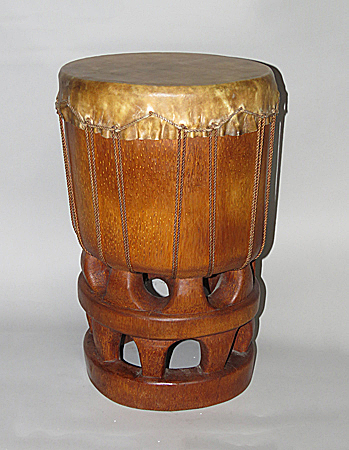
Owner: HWMC
Catalog#: 2OC-MBST-06
Struck Membranophones
Hawaiian 'Pahu' Drum (A)
Hawaiian Islands
Polynesia
Wood, hide, fiber
ca. 1985
Height: 23.5 in; Diameter: 14.25 in
Membranophones – Directly Struck
Signed: Kuno 85
This pahu is made from the hollowed-out log of Koa wood. The drumhead comes from possibly a mano, or shark, and is secured to the drum using braided olona and coconut fiber. The pahu drum is played by kumu hula (hula teachers) and ho’opa’a, or hula chanters, who produced sound by lightly striking the drum with the fingers and palms of their hands. A smaller coconut drum, called puniu, is tied to the musician’s/chanter’s knee and played with the left hand. The pahu produces a deep tone that is complemented by the higher pitched puniu.
According to some traditions, sharkskin pahu drums first appeared in Hawai’i five or six hundred years ago when La’a-mai-kahiki, a chief’s son, brought the tradition from Tahiti. Although sharkskin drums were used all over East Polynesia, contemporary researchers agree with the oral history and consider the Tahitian tradition to be the progenitor of Hawaii’s pahu drums. Originally the pahu was used in the hula pahu, which was called a kapu, or sacred dance reserved for high-ranking figures such as chiefs or gods. The larger drum, called pahu heiau (‘temple drum’), was used exclusively in the pre-Christian places of worship, called heiau. It was only after the kapu system was abolished in 1819 that the Hula masters adapted it into a smaller drum they called pahu and used it more casually in hula.
Resource: ‘Pahu,’ Mervyn McLean. ‘The Groves Dictionary of Musical Instruments,” 2nd Ed., Laurence Libin, Editor in Chief. Oxford University Press, Vol. 4., pg. 4
